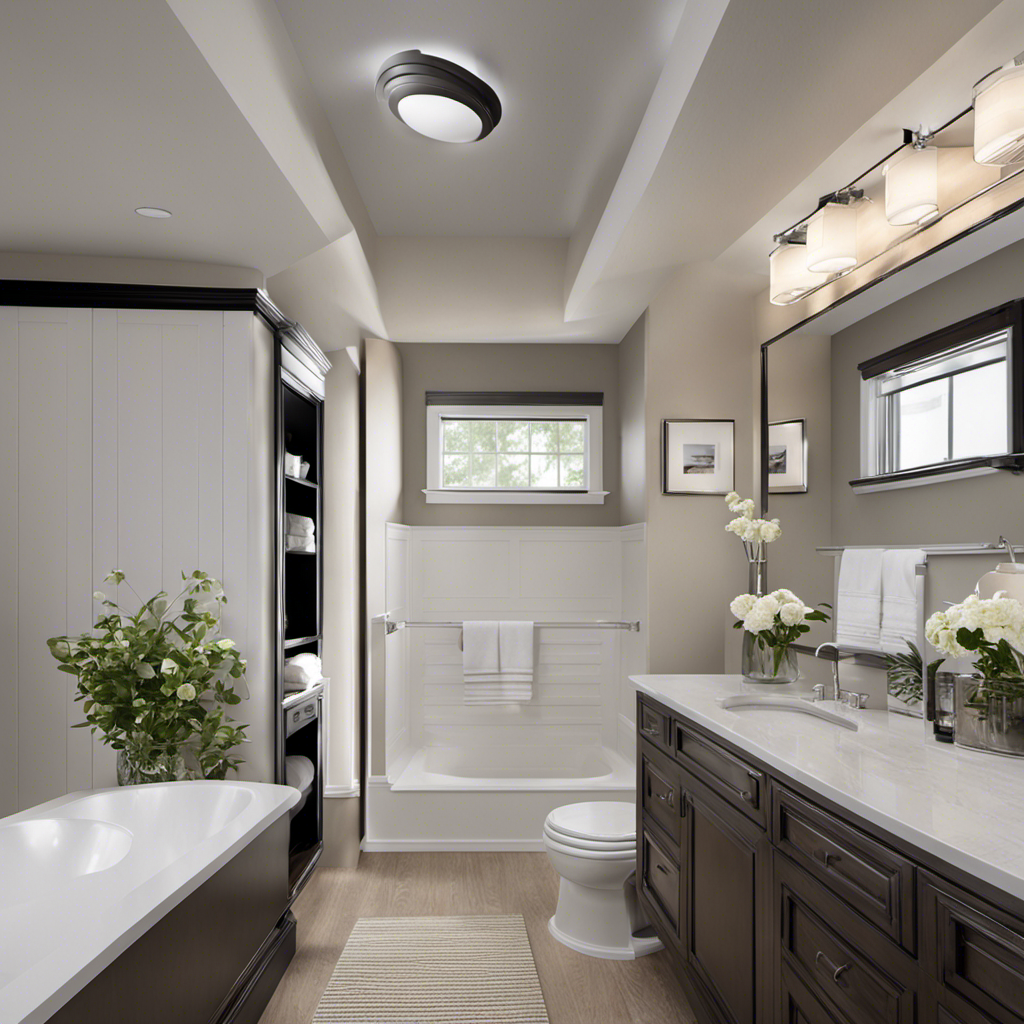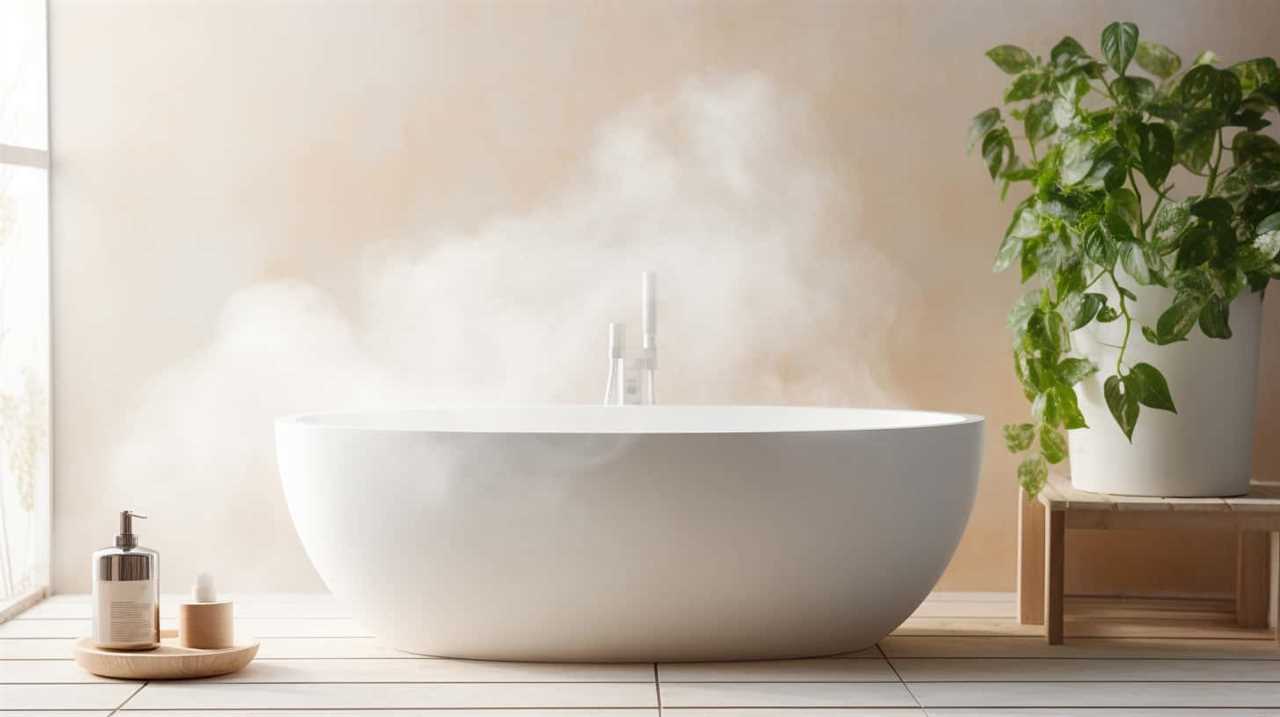Are you looking for the best way to vent your bathroom exhaust fan? Look no further than this comprehensive guide.
Inside, you’ll find all the information you need on various venting options, including:
- Ceiling-to-exterior wall venting
- Roof vent installation
- Through wall venting
- Through soffit vent installation
Learn about the benefits, potential issues, and installation considerations for each option.
Plus, discover essential factors to consider when operating your bathroom exhaust fan for optimal moisture removal and energy efficiency.
Don’t let improper ventilation lead to mold growth and structural damage – let this guide show you the way.
Key Takeaways
- Ceiling-To-Exterior Wall Venting Option is a DIY-friendly and affordable option that requires less ducting and includes features like flappers and vent hoods to prevent pests from entering.
- Roof Vent Installation offers a wide range of options with pest-proof designs and larger vent sizes, but professional installation is recommended to prevent leaks and condensation issues.
- Through Wall Venting Option provides a streamlined design for wall installations with multiple venting options at a reasonable price, but wiring may require an electrician’s assistance and care should be taken to prevent leaks.
- Through the Soffit Vent Installation offers discreet venting options, but it may potentially violate building codes, interfere with attic ventilation, and have a challenging installation process. Plastic vents also have minimal advantages compared to drawbacks.
Ceiling-To-Exterior Wall Venting Option
The ceiling-to-exterior wall venting option is a DIY-friendly and affordable choice for bathroom exhaust fans. It requires less ducting, making the installation process easier and more cost-effective. However, it is important to monitor potential blockages and take preventive measures against pests. Flappers and vent hoods should be used to ensure that unwanted critters do not enter the venting system.
When comparing ceiling-to-exterior wall venting with other venting options, it is important to consider the pros and cons. While this option is convenient and budget-friendly, it may not be suitable for all situations. Other venting options such as roof vent installation, through wall venting, and soffit vent installation offer their own unique advantages and disadvantages.
It is recommended to evaluate the specific requirements of the bathroom and consult with professionals for the best venting solution.
Roof Vent Installation
Roof vent installation offers a wide range of options for efficient and pest-proof ventilation. When it comes to choosing the right venting material, homeowners have various options to consider. The table below provides a comparison of different materials commonly used for roof venting:
| Material | Benefits | Drawbacks |
|---|---|---|
| Stainless Steel | Durable and long-lasting | Expensive |
| Plastic | Affordable and lightweight | Less durable |
| Aluminum | Lightweight and corrosion resistant | Not as durable as stainless steel |
| Copper | High aesthetic appeal and excellent durability | Expensive and requires professional installation |
Each material has its own advantages and disadvantages, so it is important to weigh them carefully when choosing the right roof venting material for your home. Consider factors such as budget, durability, and aesthetic preferences to make an informed decision. Proper roof vent installation not only ensures efficient ventilation but also helps prevent pest infestations and maintain a healthy living environment.
Through Wall Venting Option
Installing a through wall vent offers a streamlined design for wall installations and provides multiple venting options. This option is reasonably priced and can be a great choice for bathroom exhaust fan venting.
However, there are pros and cons to consider. One of the main advantages is the flexibility it offers in terms of venting options. Through wall vents can be installed directly through an exterior wall, eliminating the need for extensive ductwork. Additionally, they are relatively easy to install and can be a DIY project for those with some basic handyman skills.
However, there are also a few drawbacks. Wiring for the vent may require the assistance of an electrician, and care should be taken to prevent leaks around the vent opening.
Overall, through wall venting can be a convenient and efficient option for bathroom exhaust fan installations.
Through the Soffit Vent Installation
When considering ventilation options for bathroom exhaust fans, one option to explore is through the soffit vent installation.
Soffit venting offers both advantages and disadvantages for bathroom exhaust fans. One advantage is that it provides a discreet venting option, as the vent is installed in the soffit, which is the underside of the eaves of a house. This allows for a cleaner and more aesthetically pleasing appearance.
However, there are also some challenges in installing a soffit vent for a bathroom exhaust fan. One common challenge is that it may potentially violate building codes, as some codes require bathroom exhaust vents to be located a certain distance above the ground. Additionally, installing a soffit vent may interfere with attic ventilation, which can lead to issues with moisture buildup and potential damage to the attic.
Overall, while soffit venting may provide a discreet option, it is important to be aware of the potential disadvantages and challenges associated with this type of installation.
Bathroom Exhaust Fan Operation
Running the bathroom exhaust fan for about 20 minutes after a shower effectively removes excess moisture and prevents mold growth. This running duration strikes a balance between effective moisture removal and energy efficiency.
It is important not to leave the fan running longer than necessary, as it can damage the motor and increase the electric bill. Leaving the fan on overnight is also not advisable.
By running the fan for the recommended duration, you can effectively remove moisture from the bathroom and maintain a healthy environment. This not only prevents mold growth but also reduces energy consumption.
It is a simple and cost-effective way to ensure proper ventilation and protect your home from potential moisture-related issues.
Proper Ventilation and Health Considerations
Proper ventilation is crucial for maintaining indoor air quality and preventing potential health hazards. Inadequate ventilation can lead to mold growth and structural damage when warm air is vented into crawl spaces or garages.
The benefits of proper ventilation include preventing moisture buildup, which in turn reduces the risk of mold growth. It also helps maintain the integrity of the structure and ensures a healthy indoor environment.
Inadequate ventilation, on the other hand, can lead to a variety of health hazards. Mold growth can cause respiratory issues and allergies, while structural damage can compromise the safety and stability of the building.
It is important to direct air outdoors to prevent moisture buildup and protect both the occupants and the structure itself.
Venting Into Crawl Space or Garage
Venting warm air into a crawl space or garage can lead to mold growth and structural damage, so it is not recommended. While some homeowners may choose this option due to its convenience, there are several cons to consider.
One common mistake is failing to realize the negative consequences of this venting method. The warm, moist air from the bathroom can promote the growth of mold and mildew in the crawl space or garage, which can be harmful to both the structure and the occupants’ health. Additionally, the excess moisture can cause wood rot and other structural issues over time.
It is important to note that proper ventilation should direct the air outdoors to prevent moisture buildup and maintain a healthy indoor environment.
Exhaust Fan Ventilation Through Attics
When it comes to venting bathroom exhaust fans, one option that should be avoided is venting into the attic. This practice not only goes against building codes but also poses serious concerns for attic ventilation and potential damage.
Venting warm air from the bathroom into the attic can lead to mold growth and damage to the attic structure. Moisture from the bathroom can cause condensation issues in the attic, leading to costly repairs. Attic ventilation should always be separate from bathroom exhaust venting to ensure proper air circulation and prevent humidity-related problems.
To highlight the importance of avoiding attic venting for bathroom exhaust fans, a table is provided below showcasing the potential damage and concerns associated with this practice:
| Attic Ventilation Concerns | Potential Damage from Attic Venting |
|---|---|
| Mold growth | Structural damage |
| Condensation issues | Increased repair bills |
| Poor air circulation | Attic deterioration |
Other Considerations for Bathroom Ventilation
When considering bathroom ventilation, it is important to explore additional factors such as fresh air intake and the type of duct used.
In addition to venting challenges, another crucial consideration is the availability of fresh air intake options. While bathroom exhaust fans are designed to remove moisture and maintain air circulation, they are not specifically designed to bring in fresh air.
To ensure proper ventilation and prevent humidity-related issues, it is crucial to consider other options for fresh air intake. This can include opening windows or installing dedicated fresh air intake vents.
Flex Duct Vs Vent Pipe for Bathroom Venting
Using flexible ducting or vent pipe for bathroom ventilation provides flexibility in installation and ensures efficient airflow and proper ventilation.
Advantages of flexible ducting:
- Easy to maneuver around obstacles in the installation process
- Can be adjusted to fit different layouts and requirements of the bathroom venting system
- Allows for more flexibility in routing the ducts
Disadvantages of vent pipe:
- Less flexible and forgiving compared to flexible ducting
- Difficult to navigate around obstacles and tight spaces
- May require professional installation for complex or challenging layouts
In summary, using flexible ducting for bathroom ventilation offers advantages such as easy installation and efficient airflow, while vent pipe may have limitations in flexibility and require professional assistance in certain situations.
It is important to consider the specific needs and layout of the bathroom when choosing between these options.
Frequently Asked Questions
Can I Install a Bathroom Exhaust Fan in the Ceiling if I Don’t Have Access to an Exterior Wall?
Yes, a bathroom exhaust fan can be installed in the ceiling if there is no access to an exterior wall. This is a common alternative option for ventilation in bathrooms without exterior wall venting.
How Long Should I Run My Bathroom Exhaust Fan After Taking a Shower?
Running the bathroom exhaust fan for around 20 minutes after a shower is optimal. Extended use can damage the motor and increase electric bills. It prevents mold growth and reduces energy consumption.
Is It Safe to Vent Warm Air From the Bathroom Into a Crawl Space or Garage?
Venting warm air from the bathroom into a crawl space or garage is not safe. It can lead to mold growth and structural damage. Alternative ventilation methods should be considered to prevent these consequences.
Can I Use the Same Vent for Two Bathroom Exhaust Fans?
Using multiple fans in one vent is not recommended as it violates building codes and leads to inadequate ventilation. Switching vent locations should be done carefully to ensure proper airflow and compliance with regulations.
Can a Window Be Used as an Alternative Option for Bathroom Ventilation?
Yes, a window can be used as an alternative option for bathroom ventilation. It provides some ventilation benefits but may not be as effective as traditional units. Consider low-profile bathroom fans to prevent steam buildup and moisture.
Conclusion
In conclusion, when it comes to bathroom exhaust fan venting options, it is important to consider the specific needs and requirements of your space. Whether you choose ceiling-to-exterior wall venting, roof vent installation, through wall venting, or through soffit vent installation, each option has its own benefits and potential issues.
Proper ventilation is crucial for maintaining a healthy and mold-free environment. Remember, venting warm air into crawl spaces or garages can lead to undesirable consequences. So, choose wisely and let your bathroom breathe freely, like a cool breeze on a summer’s day.










